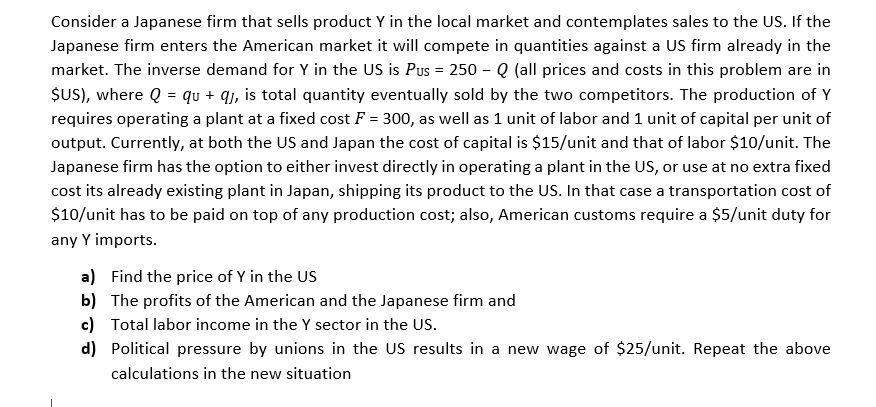Consider a Japanese firm that sells product Y in the local market and contemplates sales to the US. If the Japanese firm enters the American market it will compete in quantities against a US firm already in the market. The inverse demand for Y in the US is Pus = 250 – Q (all prices and costs in this problem are in $US), where Q = qu + qj, is total quantity eventually sold by the two competitors. The production of Y requires operating a plant at a fixed cost F = 300, as well as 1 unit of labor and 1 unit of capital per unit of output. Currently, at both the US and Japan the cost of capital is $15/unit and that of labor $10/unit. The Japanese firm has the option to either invest directly in operating a plant in the US, or use at no extra fixed cost its already existing plant in Japan, shipping its product to the US. In that case a transportation cost of $10/unit has to be paid on top of any production cost; also, American customs require a $5/unit duty for any Y imports. a) Find the price of Y in the US b) The profits of the American and the Japanese firm and c) Total labor income in the Y sector in the US.
Consider a Japanese firm that sells product Y in the local market and contemplates sales to the US. If the Japanese firm enters the American market it will compete in quantities against a US firm already in the market. The inverse demand for Y in the US is Pus = 250 – Q (all prices and costs in this problem are in $US), where Q = qu + qj, is total quantity eventually sold by the two competitors. The production of Y requires operating a plant at a fixed cost F = 300, as well as 1 unit of labor and 1 unit of capital per unit of output. Currently, at both the US and Japan the cost of capital is $15/unit and that of labor $10/unit. The Japanese firm has the option to either invest directly in operating a plant in the US, or use at no extra fixed cost its already existing plant in Japan, shipping its product to the US. In that case a transportation cost of $10/unit has to be paid on top of any production cost; also, American customs require a $5/unit duty for any Y imports. a) Find the price of Y in the US b) The profits of the American and the Japanese firm and c) Total labor income in the Y sector in the US.
Managerial Economics: Applications, Strategies and Tactics (MindTap Course List)
14th Edition
ISBN:9781305506381
Author:James R. McGuigan, R. Charles Moyer, Frederick H.deB. Harris
Publisher:James R. McGuigan, R. Charles Moyer, Frederick H.deB. Harris
Chapter12: Price And Output Determination: Oligopoly
Section: Chapter Questions
Problem 2E
Related questions
Question
Please do not paste the same incorrect asnwer.

Transcribed Image Text:Consider a Japanese firm that sells product Y in the local market and contemplates sales to the US. If the
Japanese firm enters the American market it will compete in quantities against a US firm already in the
market. The inverse demand for Y in the US is Pus = 250 - Q (all prices and costs in this problem are in
ŞUS), where Q = qu + qj, is total quantity eventually sold by the two competitors. The production of Y
requires operating a plant at a fixed cost F = 300, as well as 1 unit of labor and 1 unit of capital per unit of
output. Currently, at both the US and Japan the cost of capital is $15/unit and that of labor $10/unit. The
Japanese firm has the option to either invest directly in operating a plant in the US, or use at no extra fixed
cost its already existing plant in Japan, shipping its product to the US. In that case a transportation cost of
$10/unit has to be paid on top of any production cost; also, American customs require a $5/unit duty for
any Y imports.
a) Find the price of Y in the US
b) The profits of the American and the Japanese firm and
c) Total labor income in the Y sector in the US.
d) Political pressure by unions in the US results in a new wage of $25/unit. Repeat the above
calculations in the new situation
Expert Solution
This question has been solved!
Explore an expertly crafted, step-by-step solution for a thorough understanding of key concepts.
Step by step
Solved in 4 steps

Knowledge Booster
Learn more about
Need a deep-dive on the concept behind this application? Look no further. Learn more about this topic, economics and related others by exploring similar questions and additional content below.Recommended textbooks for you

Managerial Economics: Applications, Strategies an…
Economics
ISBN:
9781305506381
Author:
James R. McGuigan, R. Charles Moyer, Frederick H.deB. Harris
Publisher:
Cengage Learning


Managerial Economics: Applications, Strategies an…
Economics
ISBN:
9781305506381
Author:
James R. McGuigan, R. Charles Moyer, Frederick H.deB. Harris
Publisher:
Cengage Learning
